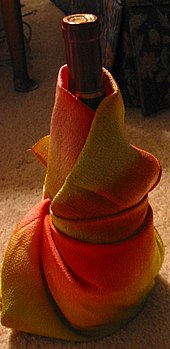Furoshiki




Furoshiki (風呂敷) are a type of traditional Japanese wrapping cloth traditionally used to transport clothes, gifts, or other goods.
History
Although possibly dating back as far as the middle of the Nara period, the name, meaning "bath spread", derives from the Edo period practice of using them to bundle clothes while at the sentō (public baths; public furo) to prevent a mix-up of the bathers' clothes. Before becoming associated with public baths, furoshiki were known as hirazutsumi (平包), or flat folded bundle. Eventually, the furoshiki’s usage extended to serve as a means for merchants to transport their wares or to protect and decorate a gift.
A historical example during World War II is a personal map printed on cloth captured from a Japanese soldier. The map was obtained by an Australian soldier, E. J. Knight, from a Japanese soldier captured on South Bougainville of the Bougainville Campaign in 1945. It is a synthetic fabric furoshiki. The cloth is printed in blue, grey, brown, mauve and orange with a map of South East Asia, and with an aeroplane, a ship and a printed patriotic marching song. The song translates as
"Both in defence and offence, we can depend on our floating castle of black steel (i.e. Japan). We must defend to the end all sides of the Japanese empire, which is our floating castle."
There is also a short hand written poem indicating that Tsuchiya is the writer's third son to enlist, "I have seen my sons leave for the battlefields three times on a fine day of play". Also on the cloth is "To Tsuchiya Akira from all the staff of the Minenobu office."[1]
Modern furoshiki can be made of a variety of cloths, including silk, chirimen, cotton, rayon, and nylon. Furoshiki are often decorated with traditional designs or by shibori. There is no one set size for furoshiki, they can range from hand sized to larger than bed-sheets. The most common sizes are 45 cm (17.7 inch) and 68–72 cm (26.7-28.3 inch).
Although there are still furoshiki users in Japan, their numbers declined in the post-war period, in large part due to the proliferation of the plastic shopping bag. In recent years, it has seen a renewed interest as environmental protection became a concern. Furoshiki are, however, commonly used to wrap and transport lunch boxes (bento) and often double as a table mat for the lunch.
On March 6, 2006, the Japanese Minister of the Environment, Yuriko Koike, created a furoshiki cloth to promote its use in the modern world.[2]
A research group in Argentina promotes the use of furoshiki through the investigation of techniques and ways to adapt to Argentine customs.[3]
Design
The design of the print can vary. The Nihonga painter Inshō Dōmoto designed fabrics. Initially they were of designs that did not use much colour, but as the colour dying techniques evolved, towards the end of his life he designed more colourful designs.[4]
The Austrian painter Friedensreich Hundertwasser also made some designs.[5]
See also
- Fukusa
- Bojagi, a similar square cloth in Korea
- Gift wrapping, the act of enclosing a gift in some sort of material
- Tenugui, a thin Japanese hand towel made of cotton
- Yukata, a Japanese summer garment
References
- ^ Unknown. n.d. Autographed furoshiki (wrapping cloth) carried by Japanese soldier Tsuchiya Akira, South Bougainville, 1945.
- ^ Minister Koike created the "Mottainai Furoshiki" as a symbol of Japanese culture to reduce wastes, Ministry of the Environment
- ^ "Nosotros". Grupo de Investigadores de Furoshiki y sus Técnicas. Retrieved August 29, 2015.
- ^ http://page8.auctions.yahoo.co.jp/jp/auction/h228855709
- ^ http://www.hundertwasser.com/apa/view-26
External links
![]() Media related to Furoshiki at Wikimedia Commons
Media related to Furoshiki at Wikimedia Commons
- Some common furoshiki folding patterns
- Youtube: Kakefuda, Kyoto (Another tutorial videoclip).
